
 physical or emotional suffering and discomfort caused by illness or injury. Pain can be classified based on pain physiology, intensity, time course, type of tissue affected, and syndromes. Physiologically, for example, pain could be nociceptive (from Latin nocere 'to harm or hurt') including mechanical (e.g., pinched skin), thermal (burn) and chemical (iodine in a cut, chili powder in the eyes, lactic acid in muscles); neuropathic (neuralgia, nerve trauma) and inflammatory (e.g. from repetitive strain).
Comments
 Paleness, also called whiteness, pale/gray complexion or pallor, is an abnormal loss of color from normal skin or mucous membranes. It is caused by reduced blood flow or a decreased number of red blood cells (anemia). Unless pale skin is accompanied by pale lips, tongue, palms of the hands, inside of the mouth, and lining of the eyes, or if it develops suddenly, or if it is accompanied by shortness of breath, blood in the stool, or other unexplained symptoms. it is probably not a serious condition, and does not require treatment. General paleness affects the entire body. It is most easily seen on the face, lining of the eyes, inner mouth, and nails. Local paleness usually affects a single limb. How easily paleness is diagnosed varies with skin color, and the thickness and amount of blood vessels in the tissue under the skin. Sometimes it is only a lightening of skin color. Paleness may be difficult to detect in a dark-skinned person, and is detected only in the eye and mouth lining. Paleness can be caused by:
Tests that may be ordered include:
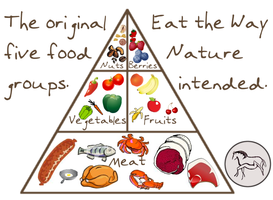 a diet based on the types of foods presumed to have been eaten by early humans before farming began. It mostly consists of meat, fish, vegetables, and fruit, but not dairy or grain products and processed food. Small amounts of wine are also acceptable, as winemaking may have originated in the Paleolithic era, when early humans drank the juice of naturally fermented wild grapes from animal-skin pouches. The diet can be traced back to 1975, when a gastroenterologist hypothesized it could make people healthier, but it became popular only in early 2000s. 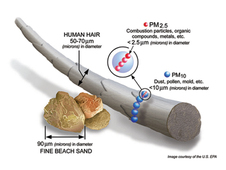 solid or liquid particles found in the air with a diameter of 10 micrometers or less (0.0004 inches or one-seventh the width of a human hair). EPA's health-based national air quality standard for PM-10 is 50 µg/m3 (measured as an annual mean) and 150 µg/m3 (measured as a daily concentration). Particulate matter 2.5 micrometers or less in diameter. (PM2.5) is generally described as fine particles PM10 and PM2.5 particles make up a large proportion of dust that can be drawn deep into the lungs. Some particles are large or dark enough to be seen as soot or smoke. Others are so small they can be detected only with an electron microscope. Larger particles tend to be trapped in the nose, mouth or throat. Because particles originate from a variety of mobile and stationary sources (diesel trucks, cars, woodstoves, power plants, lawn mowers, leaf blowers, volcanoes, etc.), their chemical and physical compositions vary widely. 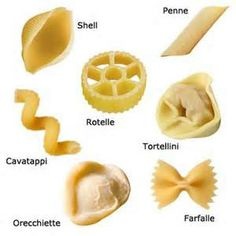 a side dish originally from Italy consisting of dough made from durum wheat and water, extruded or stamped into various shapes and typically cooked in boiling water. Classic pasta shape is long and rounded, perfect for twirling around a fork. Spaghetti (“A length of cord”) is America’s favorite shape. Vermicelli is s slightly thinner than Spaghetti, and Capellini (Angel hair) is the thinnest. Acni de Pepe is “Peppercorn”-like, bucatini is straw-like. Rotelle (“Little Wheels”) looks like a cartwheel. Rigatoni (“Large Grooved”) has ridges and holes. Most regular semolina white pasta and whole wheat pasta is vegan. Egg noodles are not, unless it's a "faux egg noodle" variety.  "People Are Allergic To Me" (PATM, coined in 2007), condition associated with emitting unknown allergens in the air causing people nearby to have allergic reactions such as rubbing their noses and eyes, sniffing, sneezing, coughing, and clearing their throat. There could be many reasons to this reactions besides chemicals in perfume and clothing. One of them could be because of volatile chemicals emitted by skin bacteria - even if we can't smell them, nose and lung receptors can react to it. Another reason could be allergy to human dander - the minute particles we constantly shed from our skin and scalp. Allergen in human dander can arise in the epidermis itself rather than from a microorganism or other external agent. 5-10% of humans are allergic to human dander to some extent, more could be allergic to agents. Surveys reveal that PATM might be associated with diet, especially dairy, coffee and alcohol. Antibiotic use might be contributing to the onset of PATM. Probiotic supplementations has mixed results, but Saccharomyces boulardii seems most helpful. Social sneezing and nose-scratching factors can not be also excluded. There is no clear scientific evidence that sneezing is contagious in the same fashion as catching a yawn, but this does not mean it can't happen. Most frequent co-occurring symptoms of those people are allergic to, are itchy skin - similar to known reactions to allergens in dander. 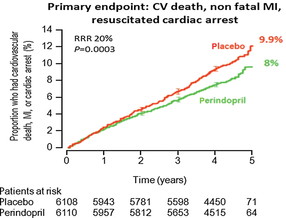 Perindopril is a long-acting ACE inhibitor used to treat high blood pressure (recommended for the initial management of hypertension especially in ages younger than 55), heart failure, or stable coronary artery disease in form of perindopril arginine (trade names include Coversyl, Coversum, Coverex, Acertil, Prestarium (Престариум А), Prexum) or perindopril erbumine (Aceon, Armix, Coverene, Perineva, Prenessa, Vectoryl) For perindopril as treatment for hypertension, the initial dose is 5 mg perindopril arginine (or 4 mg perindopril erbumine) once daily, then the dose may be increased to 10 mg perindopril arginine (or 8 mg perindopril erbumine) after one month of treatment to improve blood pressure control or in case of concomitant stable coronary artery disease. The Anglo-Scandinavian Cardiac Outcomes Trial showed the benefits of taking the two drugs perindopril and amlodipine together. 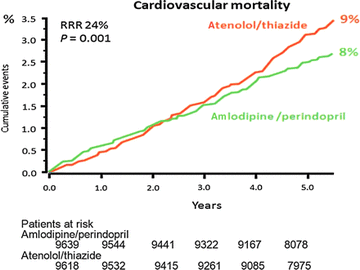 Combination of Perindopril arginine (ACE inhibitor) and Amlodipine (calcium channel antagonist) used as an antihypertensive drug and for improving the prognosis of patients with coronary artery disease (CAD). The interest of fixed-combination perindopril/amlodipine came from the results of ASCOT trial, the first trial with a comparison of antihypertensive regimens including two drugs in each arm: perindopril+amlodipine vs. atenolol+a diuretic. Brand names: Acerycal; Amlodipine/perindopril; Bi-Prestarium; Calcertil; Co-Prestarium; Coveram; Covercard; Covercor; Coverlam; Coversical; Coversyl AM; Perindopril arginine/amlodipine besylate; Prestalia; Prestance; Prestarium-Co; Presteram; Prexanor; Proacertil; Procoversyl; Reaptan; S-05985; Viacoram  technically a berry, yellow-orange fruit from 1.5 to 9 cm (0.5 to 4 in) in diameter, that may be spherical, acorn-, or pumpkin-shaped, eaten fresh, dried, raw, or cooked. The ripe fruit have a high glucose content. There are astringent and non-astringent types of persimmon. Astringent persimmons (like heart-shaped Hachiya) contain very high levels of soluble tannins if eaten before completely softened. Persimmons contain high levels of dietary fiber, phenolic compounds, potassium, magnesium, calcium, iron and manganese, vitamin C and beta carotene, and compounds with possible anti-tumor properties betulinic acid and shibuol. Regular consumption might improve cardiovascular health and fat metabolism. The excessive absorption of tannic acid, however, can make the tongue become numb and induce gastric diseases. Crab and sweet potatoes combined with persimmons could trigger gastric issues too, possibly because proteins and tannins form insoluble complexes under some conditions. Persimmons can lower blood pressure, and are not recommended to be eaten up to 2 weeks before and after surgery. 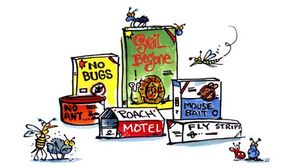 substances used for destroying pests - insects or other organisms harmful to cultivated plants or causing some type of damage to humans and other animals. Pesticides can be grouped based on pests they kill (Insecticides, Herbicides, Bactericides, Fungicides, Larvicides, Miticides, Rodenticides), by the numbers of different kinds of insects they kill (broad spectrum vs narrow spectrum - such as IGRs - Insect growth regulators, e.g., chitin synthesis inhibitors) , by how long they last (short term vs residual), and based on their active ingredients/mechanism of action (synthetic, organic, inorganic and biorational). Synthetic pesticides are further grouped into similar chemical classes such as organochlorines, organophosphates,pyrethroids, and carbamates. Newer synthetic pesticides are more pest specific, exhibit lower toxicity and are less environmentally damaging. Organic pesticides such as rotenone, pyrethrum, nicotine, neem oil, and all of the botanical pesticides are products of living organisms, often used by them naturallu to protect themselves from parasites, predators and pathogens. Organic does not necessarily equal low toxicity and environmentally safer. Inorganic pesticides - such as borates, silicates and sulfur, are minerals that work as poisons or by physically interfering with the pest. Older "inorganics" included such highly toxic compounds as arsenic, copper, lead and tin salts. Current inorganic pesticides suh as Borates: Bora Care and Timbor are relatively low in toxicity and have low environmental impact. Biorational pesticides - oils, insecticidal soaps, and microbials (such as Bacillus thurengienesis and entomopathogenic nematodes), botanicals (plant-based) and insect growth regulators have minimal impact on species for which they are not intended and exhibit lowest impact on the environment. To delay the development of resistance, it's best to apply pesticides only when they are needed, by rotating between different chemical classes, and by using rates of pesticides within the labeled range. Integrating non-chemical approaches such as pheromone mating disruption and cultural controls can also help delay resistance. |
Categories
All
|
